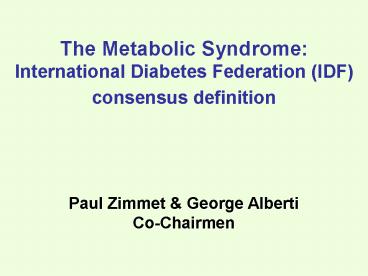International Diabetes Federation IDF Consensus Definition 2005 - PowerPoint PPT Presentation
Title:
International Diabetes Federation IDF Consensus Definition 2005
Description:
The new IDF definition focusses on abdominal obesity rather than insulin resistance ... Diet, Exercise, Lifestyle change. Stop smoking. CB1 Receptor Blocker ... – PowerPoint PPT presentation
Number of Views:55
Avg rating:3.0/5.0
Title: International Diabetes Federation IDF Consensus Definition 2005
1
The Metabolic Syndrome International Diabetes
Federation (IDF) consensus definition
Paul Zimmet George Alberti Co-Chairmen
2
METABOLIC SYNDROME
- A cluster of risk factors for diabetes and
cardiovascular disease
3
The Metabolic Syndrome
(Deadly Quartet)
- A cluster of risk factors for diabetes and
cardiovascular disease consisting of - Central (abdominal) obesity
- Diabetes, IFG and IGT
- Hypertension
- Dyslipidaemia
4
International Diabetes Federation (IDF) consensus
definition
- In 2004, the IDF held an expert workshop to
examine how the currently available definitions
for the Metabolic Syndrome could be improved and
developed with the aim of reaching a consensus
for the introduction of a new and unifying
definition.
5
THE ORIGINS
- 1920s
- 1940s/50s Vague
- 1967 Avogaro Crepaldi
- 1988 - Reaven
6
Kylin 1923 Description
- Kylin E
- Studien ?ber das Hypertonie-Hyperglykämie
Hyperurika miesyndrome -
1923
7
Crepaldi 1965 Description
- seems to suggest a peculiar syndrome including
hyperlipemia, obesity and diabetes. The
development of ischaemic heart disease and
hypertension is often found in these patients. - Avogaro Crepaldi, 1965
8
The 2000 WHO Working Group attempt to describe
define the Metabolic Syndrome was an initiative
to create interest and debate it was never
meant to be the final answer.
9
Metabolic Syndrome WHO 1999
At least 1 of
at least 2 of
- Type 2 diabetes
- IGT
- Insulin resistance
- Hypertension
- Obesity
- Raised TG or low HDL
- Microalbuminuria
- Hyperuricemia
- Hypercoagulability
- Hyperleptinemia
Not required for definition,
but may be part of the syndrome
10
The Metabolic Syndrome (ATP III)
Criteria
NCEP ATP III. JAMA. 20012852486-2497.
11
EGIR Definition of Metabolic Syndrome 1999
- Insulin resistance 2 or more of
- Central obesity (94 cm -M 80 cm - F)
- TG gt2.9 mM OR HDL lt1.0
- Hypertension (gt 140/90)
- FPG gt 6.1 mM
12
The Metabolic Syndromein Australia Different
Prevalences for Different Criteria
13
Prevalence of the Metabolic Syndromein
Australian Adults (gt25 years) AusDiab
14
Metabolic Syndrome prevalence3 definitions in
Australians - AusDiab
WHO (25.3)
ATP III (22.4)
4.8
4.3
12.0
4.8
4.2
0.8
EGIR (19.0)
2.0
15
RESULT
- Confusion!!!
16
(No Transcript)
17
Central obesity a driving force for
cardiovascular disease diabetes
Balzac by Rodin
Front
Back
18
Developing A New Definition of the Metabolic
Syndrome IDF Objectives
- Needs
- To identify individuals at high risk of
developing cardiovascular disease (and diabetes) - To be useful for clinicians
- To be useful for international comparisons
19
International Diabetes Federation (IDF) Consensus
Definition 2005
- The new IDF definition focusses on abdominal
obesity rather than insulin resistance
20
International Diabetes Federation (IDF) Consensus
Definition 2005
21
Tests Recommended for Research May Be Added To
Definition Later
CRP
Insulin Resistance
Adipo- nectin
?TG IFG Diabetes
? BP
Abdominal Obesity
Microalb
?HDL
PAI-1
Apo B Little LDL
HOMA, euglycemic clamp, fasting insulin etc
22
Treatment of Metabolic Syndrome 2005
23
Recommendations for treatment
- Primary management for the Metabolic Syndrome
is healthy lifestyle promotion. This includes - moderate calorie restriction (to achieve a 5-10
loss of body weight in the first year) - moderate increases in physical activity
- change dietary composition to reduce saturated
fat and total intake, increase fibre and, if
appropriate, reduce salt intake.
24
Management of the Metabolic Syndrome
- Appropriate aggressive therapy is essentialfor
reducing patient risk of cardiovascular disease - Lifestyle measures should be the first action
- Pharmacotherapy should have beneficial effects on
- Glucose intolerance/diabetes
- Obesity
- Hypertension
- Dyslipidaemia
- Ideally, treatment should address all of the
components of the syndrome and not the individual
components
25
Summary new IDF definition for the Metabolic
Syndrome
- The new IDF definition addresses both
clinical and research needs - provides a simple entry point for primary care
physicians to diagnose the Metabolic Syndrome - providing an accessible, diagnostic tool suitable
for worldwide use, taking into account ethnic
differences - establishing a comprehensive platinum standard
list of additional criteria that should be
included in epidemiological studies and other
research into the Metabolic Syndrome































